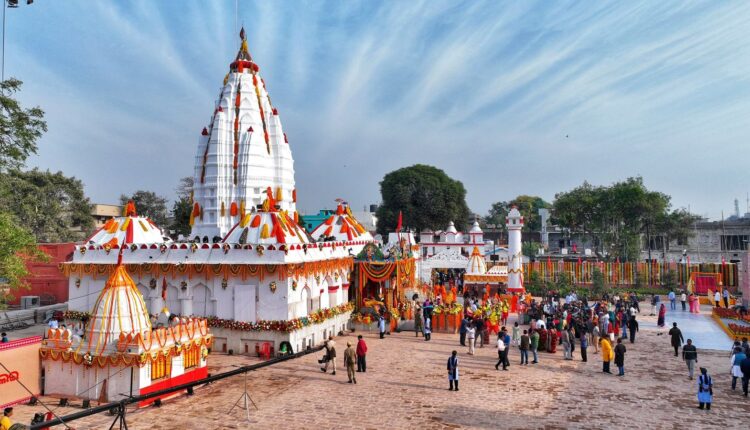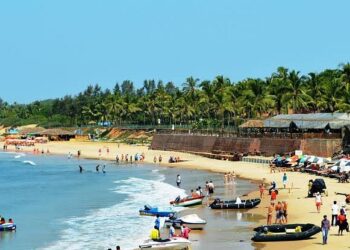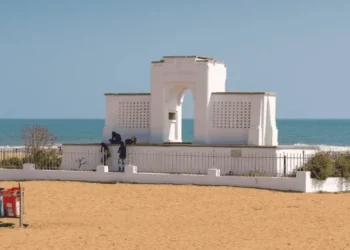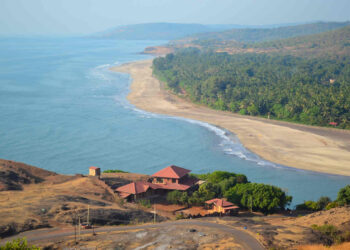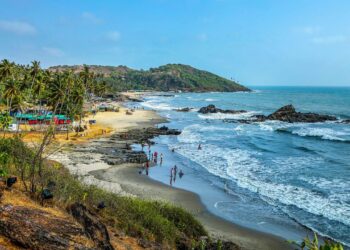Resting on the tranquil banks of the Mahanadi River in Sambalpur, Odisha, the Samaleswari Temple is a sacred Hindu shrine dedicated to Maa Samaleswari, the beloved goddess of western Odisha. Known as Samalei Maa, or Mother Samaleswari, this historic temple, built in the 16th century, is a spiritual and cultural heart of Odisha. If you want to visit this holy place, here is a simple guide on its story, look, prayers, and how to go.
Fun Fact: Sambalpur’s name comes from Maa Samaleswari, and the temple sits under a simuli (silk cotton) tree, inspiring her name.
Mythological Importance
One legend regarding Samaleswari Temple tells of King Balaram Dev, who, while hunting by the Mahanadi, saw his hounds chased by a brave hare that vanished under a simuli tree. That night, Maa Samaleswari appeared in his dream, revealing her divine presence in the river’s Gumadarha stream. The king built the temple to honor her. Another tale, from local lore, says tribal communities worshipped her under the tree since the 3rd century AD, calling her Jagatjanani, Mother of the Universe. Locals believe she grants wealth and safety. As a Shakti Peetha, the temple is tied to Durga’s divine power.
Historical Overview
The temple was founded in the mid-16th century by King Balaram Dev of the Chauhan dynasty, per Tour My India. Rebuilt by King Chhatra Sai Deo between 1657 and 1665, it was finished in 1695, per sambalpur.odisha.gov.in. Sambalpur, once called Hirakhanda for its diamond trade, was noted by Ptolemy as Sambalak in the 2nd century AD. A stone from 1246 CE near the temple suggests earlier worship. In the 1700s, Maratha rulers, like Rani Ratnaprabha Devi, restored it. By the 1800s, it was a major pilgrimage site. After 1947, Odisha’s government took over. The 2021 SAMALEI project, launched by CM Naveen Patnaik, added paths and shops, keeping its old look. Odia poet Bhima Bhoi sang of Samaleswari, spreading her fame. Today, it draws lakhs to Sambalpur’s holy land.
The temple’s past is rich. Some say it was a Tantric center, per Incredible India. British scholars in the 1900s noted its role in Odia culture. Recent digs found coins from 1500 CE, proving its age. Its riverside setting and tribal roots make it a unique Shakti shrine.
Architecture of Samaleswari Temple
Samaleswari Temple, on 108 acres by the Mahanadi, blends Kalinga and Chalukyan styles, per Medium. The main shrine, rebuilt in 1695, has a rekha deul tower with carvings of Durga, Kali, and flowers on gray khandolite stone. The sanctum holds Maa Samaleswari’s idol—a granite block with a trunk-like base, not shaped by humans, adorned with gold and a Sambalpuri nose ring, symbolizing motherhood. Eleven side goddesses, like Maa Mangala, line the sanctum’s outer walls for parikrama, per Odisha Heritage.
The complex has two parts: Badagudi (main temple) and Sanagudi (mandap), where Ganesha and other deities face Maa Samaleswari. The Sanagudi has pillars with vine carvings. Smaller shrines for Durga, Kali, and Ramchandi are in the yard, carved in black stone. The courtyard, paved with khandolite, feels sacred, shaded by simuli and neem trees. A ritual tank by the river, with plain edges, is for baths. Low walls have niches for minor gods, like Nagas, guarding the site. Wall carvings show Samaleswari’s lion and Durga’s tales, guiding faith. The 2021 SAMALEI project added a 1-km parikrama path, per Tour My India.
Rituals and Festivals
The temple hosts joyful festivals. Nuakhai, in August or September, is the biggest, a harvest festival where devotees offer new rice to Maa Samaleswari. Navratri, in September or October, features Dhabalamukhi Besha, believed to grant Ganga darshan. Jyestha Purnima honors Bhairava Baba’s Jalasayee, and Sravana Purnima has Srabanbhishek. Daily rituals include morning chants, Archana, and evening aarti. Special pujas like Dhabalmukhi Puja cost ₹100-500, per BhaktiBharat.com. A prasad stall gives free jaggery sweets. Tuesday pujas with sindoor seek strength.
Odissi dance and Sambalpuri martial arts during Nuakhai add cultural charm. A ₹50 special pass skips long queues.
Information for Travelers
Hours and Entry: Open daily, 6:00 AM to 11:30 AM, then 3:00 PM to 7:30 PM. Entry is free, but pujas cost ₹100-500. Photos are fine outside, not in the sanctum.
Clothing: Wear simple clothes covering shoulders and knees. Men for rituals wear dhotis, often no shirt.
How to Get There:
Air: Veer Surendra Sai Airport, Jharsuguda, 63 km away, is closest. Taxis take 1 hour, ₹1000-1500. Biju Patnaik Airport, Bhubaneswar, is 300 km away.
Train: Sambalpur Railway Station, 4 km away, connects to Kolkata (8 hours) or Bhubaneswar (5 hours). Autos cost ₹50-100.
Road: Buses from Bhubaneswar (320 km) or Cuttack (300 km) reach Sambalpur’s bus stand, 2 km away. Autos cost ₹20-50.
Places to Stay:
Sambalpur has hotels like Hotel Sheela Towers (₹2000-3000) or Hotel Konark (₹1000-2000). Budget guesthouses cost ₹500-1000. Stalls sell dosa, puri, and tea. Try Sambalpuri Dalma at Hotel Grand Siba.
Best Time to Visit:
October to March, 20-30°C, is cool. Weekdays are quiet. Nuakhai and Navratri are busy, so book early.
Nearby Attractions:
Hirakud Dam, 16 km away, is the world’s longest earthen dam.
Huma Leaning Temple, 27 km away, is a tilted Shiva shrine.
Budharaja Temple, 20 km away, offers scenic views.
Debrigarh Wildlife Sanctuary, 40 km away, has tigers.
Ghanteswari Temple, 33 km away, is a sacred site.
Final Thoughts
Samaleswari Temple in Sambalpur, Odisha, a holy land in eastern India, is a treasure of faith. Its unique idol, riverside calm, and lively festivals draw devotees and travelers. Maa Samaleswari’s divine touch fills its riverside, making it a must-see among Odisha’s sacred places.
